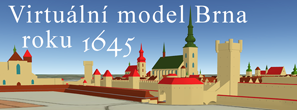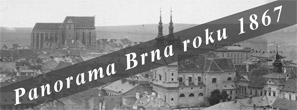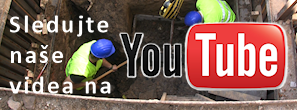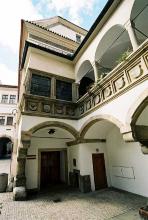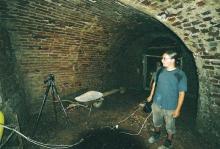Grant Projects
Royal town Brno at the turn of the 14th and 15th centuries (2005-2007)
GAČR No. 404/05/2755, investigators: Mgr. Kateřina Urbánková and Mgr. Veronika Wihodová
„Chronologie brněnské keramiky v období od 12. až do počátku 14. století“
– Chronology of the Brno pottery from the 12th to the beginning of the 14th century (2004-2006)
GA AVČR No. A8001402, co-investigator: Mgr. Marek Peška.
"Hrad Přerov a polský průnik na Moravu kolem r. 1000"
The Přerov Castle and Polish intervention in Moravia around 1000 (2003-2005)
GAČR No.404/01/0490, investigator: PhDr. Rudolf Procházka, Csc.
"Archeologie středověkých měst v českých zemích"
Archaeology of medieval towns in Czech lands (2001-2003)
GAČR No. 404/010490, co-investigator: PhDr. Rudolf Procházka, Csc.
"Měšťanský dům středověkého Brna"
Burgher house in medieval Brno (2001-2003)
MK ČR No. PK01P04OPP006, investigator: PhDr. Rudolf Procházka, Csc.
Co-investigators: David Merta, Mgr. Marek Peška, Jaroslav Sadílek.
"Struktura sídlištního materiálu z mladší doby bronzové"
Young Bronze Age (2001-2002)
GAČR No. 404/01/1407, co-investigators: Mgr. Peter Kováčik and Mgr. Marek Peška..
„Středověké město a jeho zázemí“
Medieval town and its hinterland (1998-2000)
GAČR No. 404/98/0968, investigator: PhDr. Rudolf Procházka, Csc.
In 1998 – 2000 the Brno department of the civil association Archaia Praha took part in the work on the grant project of the Czech Science Foundation No. 404/98/0968 „Medieval town and its hinterland“ . The contribution of the department consisted in solving the question of transformation of an early medieval agglomeration into a medieval town and the problem of development of the early and high medieval occupation within the framework of a landscape probe on the right bank of the Svratka River between Komárov and Rajhrad. Within the scope of this project surface prospecting had been performed in cadastres of formerly independent municipalities of Dolní Heršpice, Horní Heršpice, Přízřenice, Modřice and Popovice. Also the results of some basic excavations in Modřice and Popovice were used, however, bringing above all evidences of prehistoric and protohistoric settlement. Principal investigator was PhDr. Rudolf Procházka, CSc., and co-investigator Jaroslav Sadílek.
Publication outputs:
Procházka, R. - Loskotová, I. (1999): K topografii předlokačního osídlení brněnského historického jádra, Archaeologia historica 24, 169 - 188.
Procházka, R. (2000): Zrod středověkého města na příkladu Brna (K otázce odrazu společenské změny v archeologických pramenech)
Medievalia archaeologica 2, 7-158.
Procházka, R. - Doležel, J. (2001): Současný stav poznání počátků jihomoravských měst, Přehled výzkumů 42, 2000, 25-74.
Procházka, R. (2001): K otázce rekonstrukce přírodního prostředí svratecko-svitavské nivy ve středověku a novověku, Niva 2001, 113 - 117.
Procházka, R. (2002): Lužní les jižně Brna ve středověku a raném novověku. In:Civitas et villa, tom poswiecony jubileu prof. Marty Mlynarskej-Kaletynowej, Wroclaw, 353 - 356.
Archaia Brno, o. p. s. also participated in the grant project of the Czech Science Foundation No. 404/010490 "Archaeology of medieval towns in Czech lands" (2001-2003). The project bearers were the Institutes of Archaeology of the Academy of Sciences of the Czech Republic in Prague and Brno. The aim was to create a monograph containing comprehensive medallions of selected medieval towns, the origins of which had been to a high degree recognised through archaeology. The company workers participated in the elaboration of particular texts about the towns Boskovice, Brno, Jihlava, Modřice, Telč, Uherské Hradiště, Uherský Brod, Znojmo.
Publication outputs:
Procházka, R. (2001): Chlebové pece předlokačního a lokačního Brna, Archaeologia historica 26, 207 - 219.
Procházka, R. (2003): Počátky jihomoravských měst a etnické změny, Archaeologia historica 28, 267 - 295.
Kováčik, P.- Merta, D. - Peška, M. -Procházka, R. (2002): Brünn - von der frühmittelalterlichen Agglomeration zur Residenzstadt des Spätmittelalters. In: Medieval Europe Basel 2002, Center - Region - Periphery, 3rd International Conference of Medieval and La!er Archaeology, Basel (Switzerland) 10. - 15. September 2002 (ed. Guido Helmig, Barbara Scholkmann, Matthias Untermann), Hertingen 2002, volume 2: sections 4 and 5, s. 248-255.
Bearer of the two-year project "Structure of settlement finds from the Young Bronze Age" No. 404/01/1407 (2001-2002) was the Department of Archaeology at the University of West Bohemia in Pilsen under the direction of Dr. Pavel Vařeka, the co-bearers then the Institute of Archaeology of the Academy of Sciences of the Czech Republic in Prague (under the direction of PhDr. Luboš Jiráň) and the Brno department of the civil association Archaia Praha, from which besides the principal investigator Mgr. Peter Kováčik also Mgr. Marek Peška, Michal Daňa and Anna Mojžíšová were involved. The project goal was the investigation of inner structure of a settlement of the Knovíz culture. For this purpose the site in Prague 10 – Hostivař was selected with uniquely preserved massive culture layer sequence, a representative part of which could be uncovered in 1999. Analysed were above all the stratigraphic, spatial and functional relations within the settlement, and the results had been compared with another settlements of given time period. The research further focused the material culture of the settlement, reflection of production and consumption of local community in archaeological sources, analysis of building culture, problem of natural sources and reconstruction of natural environment of the site. Special attention was paid to unique pyrotechnological devices.
The goal of the three-year project "Burgher house in medieval Brno" (No. PK01P04OPP006; 2001-2003) funded by the Ministry of Culture of the Czech Republic was the elaboration of a catalogue of preserved or archaeologically investigated medieval houses and their remnants in the historical core of Brno. Despite a destructive sanitation of the most part of historical building coverage there are some objects preserved within former Brno town walls, which contain relics of medieval constructions and originated in the 1st half of the 13th century already, many others had been recorded through area excavations and trenching. Until now about 100 medieval houses on various level of preservation were registered. Cataloguing also comprises the photo and drawing documentation of building elements and details. The available documentation of particular buildings is widely supplemented directly in terrain, mainly at running repairs and reconstructions. Principal investigator was PhDr. Rudolf Procházka, co-investigators were David Merta and Mgr. Marek Peška. In the project participated as authors as well the former employee of the Brno department of the civil association Archaia Praha Jaroslav Sadílek and the archaeology students Petr Holub and Václav Kolařík.
Publication outputs:
Merta, D. (2001): Nejstarší měšťanská kamenná architektura v Brně, Průzkumy památek VIII, 2001, 41-60.
Merta, D.- Peška, M. (2002): K počátkům zděné profánní architektury v Brně, Dějiny staveb 2001, 110-114.
Tíž (2003): Proměny domovního bloku Velký špalíček v Brně, Dějiny staveb 2002, 118- 129.
In 2003 the company started to work on the grant project of the Czech Science Foundation No. 404/01/0490 "The Přerov Castle and Polish intervention in Moravia around 1000" (2003-2005); co-investigator is the Institute of Archaeology of the Academy of Sciences of the Czech Republic in Brno. The main goal of the project is the elaboration of a finding horizon of the turn of the 10th and 11th centuries with accent on the verification of the presence of a Polish garrison in Central Moravia and the reflection of Polish influence in material culture. The intent emerges from rich results of rescue excavations in Přerov in 1984-2000, in which also Rudolf Procházka was taking part.
The project „Chronology of the Brno pottery from the 12th to the beginning of the 14th century“ offered by the Grant Agency of the Academy of Sciences of the Czech Republic (No. A8001402) and treated in cooperation with the Institute of Archaeology of the Academy of Sciences of the Czech Republic in Brno emerges from actual state of research whereby on the basis of a quantification analysis of selected pottery assemblages from the excavations in Brno in 1984-1997 four time-defined development horizons of pottery production had been elaborated for the period from the 12th to the beginning of the 14th century. In the course of past decade appeared new stratified finding assemblages with absolute footings (dendrodata, coins) from the investigated period. Previous research in fact doesn’t doubt the chronology mentioned. Using the scientific methods, stratigraphic and statistic analysis the validity of this chronology will be verified, precised and the content of particular stages characterised. Elaborating the chronology of the Brno pottery should have the essential meaning for future research within the framework of the problems involved in the South-Moravian production sphere and therewith also for further research in the field of social changes occurring in the 13th century.
The meaning and goal of the grant project "Royal town Brno at the turn of the 14th and 15th centuries" (2005-2007) No. 404/05/2755 offered by the Czech Science Foundation consists in partial enabling of sources of economic-administrative nature deposited in the Brno City Archive following the only existing edition of Brno account books and registers issued by B. Mendl (account registers from 1367, 1387, 1389 and 1432). Using another sources from the 14th and 15th centuries deposited in the Brno City Archive a historic study should be elaborated that will capture the life in late medieval Brno from the social, cultural or topographic point of view, above all in the field of economic relations and the very operation of municipal authorities or the practice in municipal office narrowly connected with the personalities of particular town clerks. Final outcome of the project will be the edition of the four account registers stated above with elaborated name index and glossary, and a historic study counting about 150 pages, which is at the same time an introduction to this edition.
Patrimonium pro futuro
12. 06. 2025 – – zobrazit


